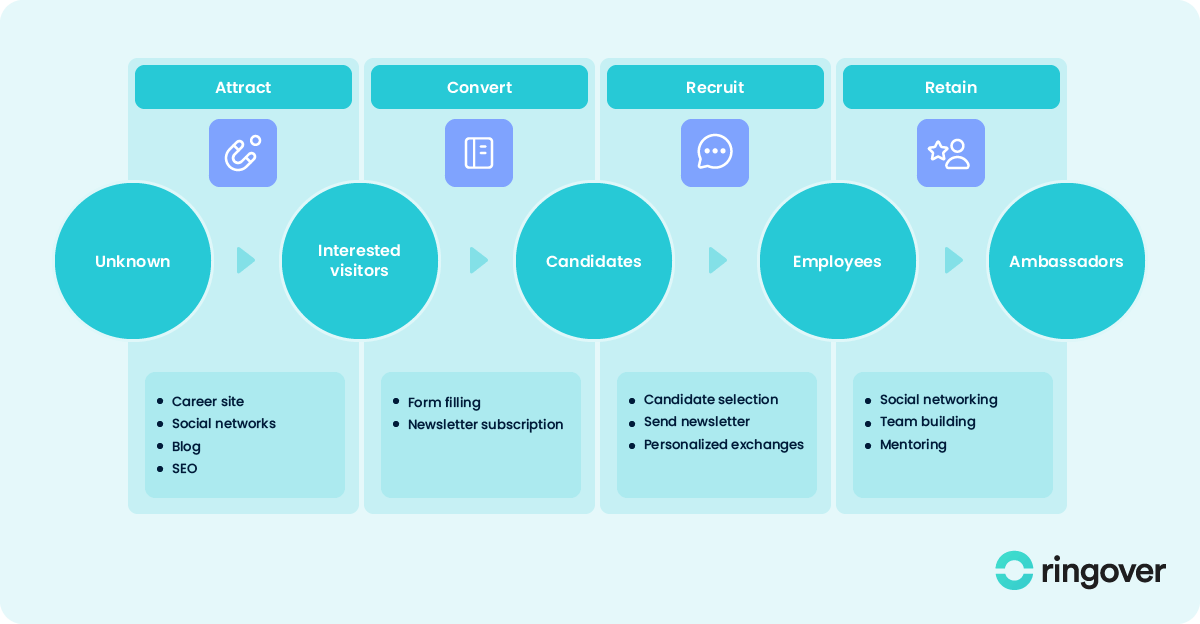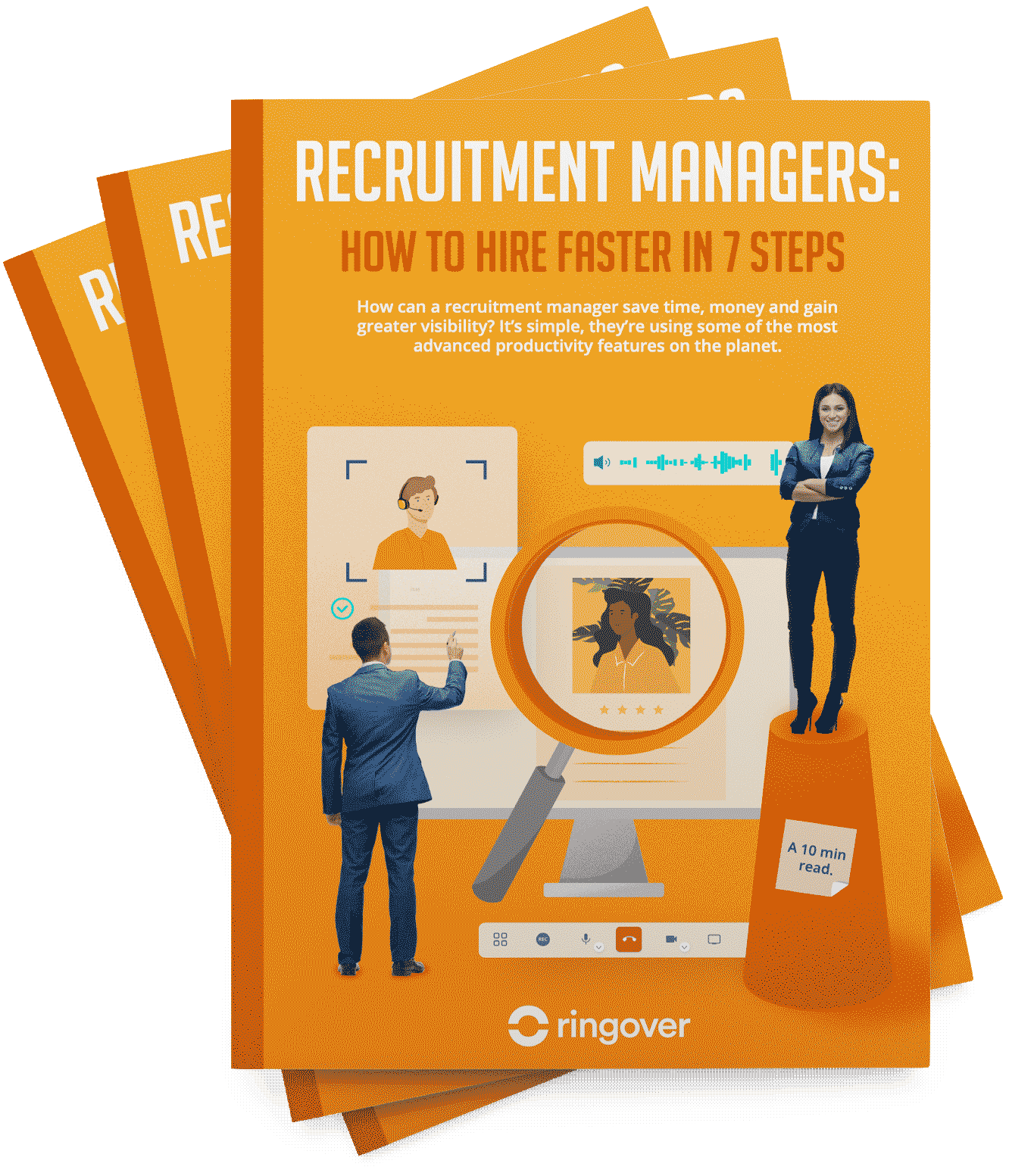Summary
The competition between companies is fierce. To attract the best talents, they employ now-classic levers such as social benefits or remote work.
However, it's not enough to have a good health insurance and vacation policy to feed your pool of candidates.
More and more companies are investing in inbound recruiting. But what is it? How can it transform your recruitment process?
Everything to know about inbound recruiting: definition 📝
Inbound recruiting, also called inbound recruitment or inbound hiring, is an innovative approach in the recruitment field.
Inspired by inbound marketing, it emphasizes deploying strategies to attract talents rather than actively searching for candidates.
Concretely, inbound recruiting translates into the use of tactics to attract and retain a qualified audience with qualitative content.
The 4 key steps of inbound recruiting 🧲
Analogous to inbound marketing, inbound recruiting consists of 4 steps:
- Attract
- Convert
- Hire
- Retain
1. Attract
The first crucial step of inbound recruiting lies in your ability to attract potential candidates. To achieve this, you must first define your target precisely.
Like in marketing, you'll establish a persona: a fictitious representation of your ideal candidate. It is recommended to produce three to five personas depending on the size of the organization.
Such an approach will help you better understand who you are addressing and how to distribute your recruitment efforts. There you go! Have you identified the profiles you are looking for? It is now simpler to capture the attention of your future talents. How?
By displaying, for example, a careers site that reflects your company culture with engaging texts, photos of your premises, videos showcasing your team, and informing your audience about your news.
Do the same on your LinkedIn account, but not in a chaotic way. Coordinate your posts with other departments of your company, like the marketing/brand team, to display coherence in your communication. Align your teams by using a publication schedule.
On your blog/careers site, your LinkedIn page, or Welcome To the Jungle, make sure to deploy a strategy of relevant keywords related to your industry and your location.
The idea is to cover all the queries of your targets in the subtitles, titles, and URLs of your pages. To do this, again, you can rely on your internal skills, especially your SEO team.
Most of all, don't forget your larger objectives: increase your visibility and build a stronger brand.
2. Conversion
The conversion phase is an essential step in the inbound recruiting strategy. It helps to turn visitors interested in your company into active candidates potentially qualified for the positions to be filled.
The objective of this phase is to collect information about interested visitors in order to be able to contact them again and assess their suitability for the vacant positions. Depending on your goals, conversion is achieved using tools such as online application forms, recruitment events, signing up for a newsletter, a webinar, or a contact form.
3. Hire
During this third phase, the company sorts through the candidates who feed its pool to transform them into employees. The goal is to identify those who match the desired profiles in terms of skills, experiences, and alignment with the company culture.
It's time to offer a quality candidate experience through personalized exchanges, tutorials, and advice. The idea is to deploy a strategy to start building a strong relationship with the candidates and convince them to join your organization.
However, let's not forget that recruitment involves human relationships, and cognitive biases can impact its smooth running on both sides.
In other words, it is not certain that all solicited candidates will join you. Nevertheless, this does not mean that you should break off all contact with those who do not join you. More and more companies stay in touch with these talents via LinkedIn or their newsletter.
4. Retention

It consists of maintaining and strengthening the bond between the company and the recruited candidates. It aims to promote employee engagement and retention to create a lasting and mutually beneficial relationship.
This can be translated into initiatives such as training and mentoring programs, career development opportunities, team-building activities, and rewards for outstanding performance.
The objective is to cultivate a positive work environment where everyone feels appreciated and motivated.
The importance of retention should not be underestimated as it helps to limit the costs associated with turnover. However, although money is the lifeblood, it is not the only criterion to consider when it comes to retention.
Retention also helps to preserve know-how, expertise, and contributes to maintaining a strong corporate culture. Employees are more satisfied and engaged and can thus become valuable ambassadors.
The advantages of inbound recruiting ➕
Much more than a simple recruitment method, inbound recruiting, when skillfully used, is a powerful means to attract new talents. Let's list its main advantages:
1. Attraction of qualified talents
Inbound recruiting allows attracting qualified candidates interested in the company. By providing relevant and targeted content, the company is more likely to attract talents who share its values and vision.
2. Reduction of recruitment costs
By using inbound recruiting, companies can reduce the costs associated with candidate search. It's also an excellent way to decrease outbound recruitment expenses, especially regarding job boards.
3. Improvement of employer branding
Thanks to inbound recruiting, you can build a positive image of the company as an attractive organization. An omnichannel communication strategy on social networks can help you highlight your benefits and strengthen your reputation. This is extremely important, especially since 75% of candidates take into account an organization's reputation before applying, and social recruiting is more and more popular.
4. Employee engagement and retention
As we have mentioned previously, inbound recruiting is not limited to acquiring new talents. Indeed, it is an excellent tool for employee retention and loyalty.
What strategy for inbound recruiting? (Examples)🧠
Below, we have listed three examples of inbound recruiting strategies:
- Online events: on your site, you can set up webinars during which potential candidates can interact with the company and learn more about the opportunities it offers. At the end of the event, interested participants can start the recruitment process.
- Content distribution: You can create an inbound recruiting funnel based on the distribution of informative and relevant content. Depending on the sector, this may include blog articles, videos, white papers accessible after subscribing to a newsletter. The white papers tactic is an approach that will mainly suit senior and top management profiles.
- A strategy based on Instagram and TikTok to recruit interns: It can be complicated to find interns on LinkedIn. Generation Z appreciates its freedom and quickly tires of email solicitations but can be enticed via platforms such as Instagram and TikTok using viral content.
Inbound recruiting tools 🔧

To activate the inbound recruiting lever effectively, you will need essential tools throughout the four steps: attract, convert, hire, retain.
Here are the different tools you will need:
- Applicant tracking system (ATS) software: Essential in recruiters' arsenal, they allow handling candidates from the initial publication of job offers to the final selection and integration of chosen candidates.
- Content generation tools: If you use your site to attract talents, you will need a CMS (content management system) to gain autonomy on the publication of your career pages and blog articles. With such tools, you won't need to call on your "dev team" and will have full control over the content.
- Social networks: We've mentioned them throughout this article. Social networks, such as LinkedIn, but also Instagram and TikTok are valuable promotion tools for your employer brand and job offers.
- Marketing automation tools: To personalize your email exchanges, you will sooner or later need an automation solution to schedule and manage campaigns effectively. Such a system allows you to disseminate content at the right time automatically. Automation tools generally allow segmenting the candidate database and analyzing campaign results.
- Analytics and tracking tools: Analysis and tracking tools, such as Google Analytics, provide valuable insights into the impact of content recruitment strategies. They allow evaluating the reach of distributed content, the traffic generated on the company's website, conversion rates, and various relevant performance indicators. These data provide a solid basis for adjusting and optimizing inbound recruitment initiatives, ensuring efficient use of resources, and better response to the company's talent needs.
- Communication platform: For your telephone or video interviews with different candidates, you will also need a reliable and secure communication solution that allows you to centralize your interactions. This is precisely what Ringover offers, which has the advantage of integrating with your CRM or ATS.
It is important to choose the tools that meet the company's needs and to use them consistently to maximize the effectiveness of inbound recruiting.
What to remember 💡
Inbound recruiting is a strategic approach that radically transforms the way companies attract and engage talents. By focusing on attracting candidates rather than actively searching for them, inbound recruiting offers organizations a powerful lever to attract the best talents and strengthen their position in the labor market.
Through the different phases of the inbound recruiting process, companies can implement effective strategies to attract, convert, and retain talents sustainably. They can rely on tools such as (ATS, communication platforms, social networks, etc.).
With its 100% cloud communication solution, Ringover offers you the necessary support to successfully carry out your inbound as well as outbound recruitment campaigns. To learn more about its features, try it now!
Published on April 15, 2024.


